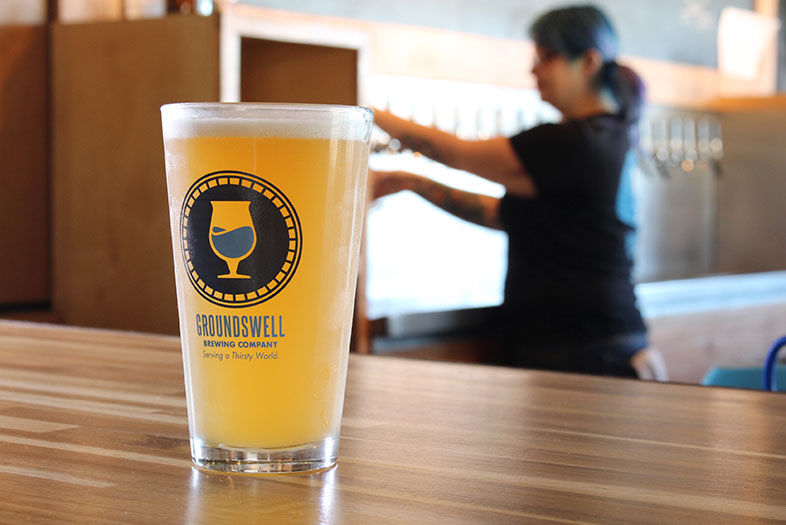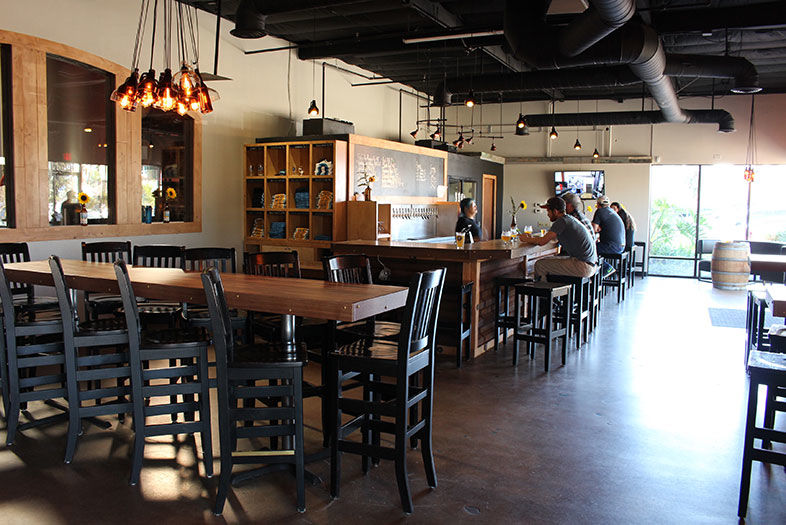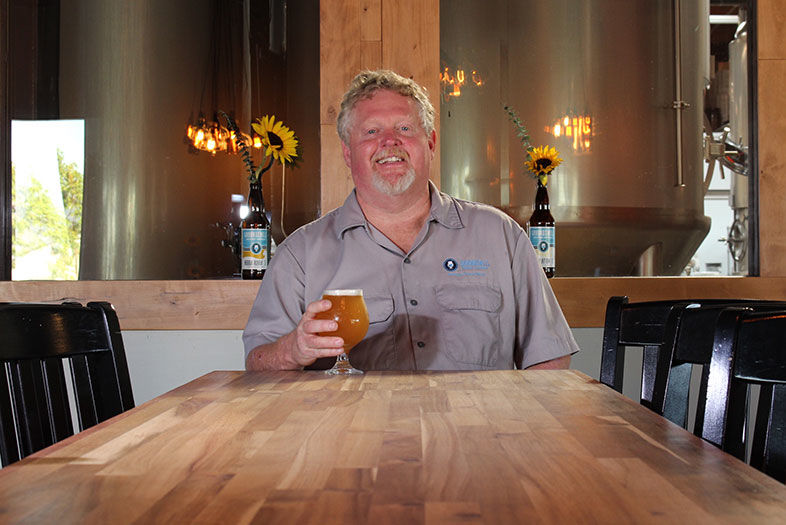For all the prudent planning and careful cash projecting that goes into the running of most businesses, sometimes you just have to throw caution to the wind and go for it. Every great entrepreneur will tell you that, at some point in his or her career, a unique opportunity presented itself and it just had to be taken.
For Kevin Rhodes, president and founder of Groundswell Brewing Company, the “big opportunity” was an empty brewery in Santee that used to be home to Twisted Manzanita. Groundswell’s original location, which opened just over three years ago in Grantville, was a cozy little neighborhood brewery and tasting room where they brewed small batches of tasty beers on a 3-barrel system.
After three years of establishing their reputation and honing their lineup, Groundswell was ready to expand, but they never dreamed they’d be going nearly overnight from production of about 1,000 barrels into a 15,000 square foot space where they could ramp up to more than 10,000 barrels a year. But sometimes you just have to take that leap…
I sat down with Kevin and a cold pint of crisp and juicy Undulation White IPA to talk about how the great expansion is going, how he plans to grow the business, and what it’s like to serve the Santee area.
You’ve barely been in your new Santee space for a month.
Yes, we officially opened on January 19th.
Despite your expansion, you’re still going to keep the Grantville location open, right?
Yes. It’s going to be just a tasting room. I’m going to pull the brew house out of it. I’ve got a guy in Florida who wants it. Unfortunately, it’s going out of the community, but he was very adamant about wanting it.
This new space increases your production capability — what? Ten-fold?
At least. Compared to the actual brew house in Grantville, it’s much more than that.
Where is all that growth going to come from?
This step — going to a bigger brew house, being able to do multiple thousands of barrels — is everyone’s dilemma when you’re in the brew business. Unless you did it really big right up front, you’re always looking to move up to this level. To build out a brewery on our own was going to be a lot more costly and it was going to take a lot longer. So, when this came along, we just knew that this would get us to a place where we could really go after distribution.
This was kind of a turnkey sale, right?
Absolutely. We bought the assets off the former brewery. So, for us, it allows us to go into distribution and to talk to people about distribution. We’ve talked to people about distribution in the past, but when you’re contract brewing (which we were in Grantville) it’s really hard to guarantee that you can bring in a definite number of barrels every month, unless you have a really big facility somewhere. Most of the time you’re in some place where they’re trying to tuck you in here or there and — if they need their beer to get out — they push their beer through while you sit and wait. And then you run out of beer. It just doesn’t work very well in the distribution world. So this allows us a lot of latitude to grow and to be in charge of our “brew destiny” as we like to say.
Have you started bottle distribution already?
We did a run of bottles with our Hubba Hubba Double IPA, our Undulation White IPA, and our Full Ginger Saison, and it went well. But we were relying on the mobile bottler and we just weren’t able to keep up. Being in a contract facility and trying to get three tanks at the same time so the mobile bottler could come down and bottle all of them was difficult. So we’ve decided to take a step back and I think we’re going to move to cans; we’re still not sure whether they’re going to be 12-ounces or 16-ounces. We’ll do bottles for our kettle sours and for our barrel-aged beers.

Have a Beer with Groundswell President Kevin Rhodes
Mango Tart, one of Groundswell’s kettle sours | Photo by Bruce Glassman
You have a lot more space for barrels here!
Oh, yeah. There’s a lot. We walked into 56 barrels full of beer here. We poured about a quarter of them down the drain because they had gone bad. The rest of them, we’re either going to fruit them or do something where we just pour them through the tasting rooms. Since we didn’t brew those beers, we don’t feel we should be selling them out in the market. But it’s beer that should be drunk.
Other than the efficiencies and the potential for much greater volume, what are some of the other things that are great about working on this new system?
Well, the efficiency is much higher, but it’s also all the equipment that you need. You have equipment to check CO2, you have real temperature controls, and all the better equipment to make sure the beer is going where it’s supposed to. I would say that’s probably the best thing. And the fact that we get to do it. Again, when you contract, you may be part of the brewing process, but you may not. And other people may make decisions that you wouldn’t make. Now, it’s only our people that have their hands on the beer, and for the whole time.
What do you say to folks who are thinking about taking a leap into a big expansion?
Those of us on the brewery side, we all understand that this takes a lot of money. It just keeps eating money like it’s a ferocious beast until, one day, you get past that distribution landmark and you’re at 5,000 or 7,000 barrels and you say, “Wow! We finally have some better cash flow!” I came out of the restaurant business, so I hadn’t realized how much money you have to invest in inventory and how long it has to sit.
In the restaurant business, your cash flow comes back in a week. Here, we’ll buy the ingredients, we’ll brew the beer — that could be a total of a month or so, and then there’s time in the cooler. So say two months is the total. Then we give 30 days credit to the bar, so — if everybody pays us on time, we get our money back in three months. And, as you grow, that inventory just gets to be bigger. So, it’s the big monster in the room.
Assuming you’ve seen an encouraging growth in your draft accounts over the past three years, where has most of that growth come from?
Mostly in the core of San Diego — from Chula Vista to Miramar. We do a little bit in North County, but there are so many breweries up in North County that it’s a little bit harder to get in there.
Are you getting out of San Diego County at this point?
We are not. We haven’t found a distributor and we don’t have a sales person. We had some of our beers tested in Los Angeles, and they went over well, but we just weren’t ready to pull the trigger on distribution. You’ve just got to have that capacity.
I expect you’ve gotten a good reception from the locals here in Santee now that you’ve reopened this location?
Absolutely. So far, it’s very friendly. And we’ve talked a little bit more about an East County Brewers Guild, and doing collaborations with other [nearby] brewers. We want to be a little more friendly than, I think, the past [brewery] had been. We’ve talked quite a bit to Finest Made, to Pacific Islander, to BNS, and to Burning Beard (we love Burning Beard!). Hopefully we’ll get to do some kind of a collaboration with them. We just want to be part of the neighborhood, to fit in, to really build this area for beer, and not just to be focused on us.
Are there other new things you want to do in your new space?
I’d like to do some contract brewing here. I’d like to prove that it can be done really well—that we can take care of someone else’s beer as well as we take care of our own. I think someone needs to prove that out. We’ve got lots of capacity, so we might as well help some of our colleagues out there that need more beer.
There’s been some noticeable contraction in the industry these past twelve to eighteen months, but you guys are obviously doing well and growing. What’s been your strategy for success?
I think for us, it’s been a number of things. For one, we’ve done a really good job getting great people. We have people behind the bar that really know beer, we have brewers that are passionate and really love what they do [Callaway Ryan, formerly of URBN St. is the head brewer, Zachary Hayes does wort production, and Brent Donovan from Toolbox just joined the brewing team]. We also have sales guys that love the industry and they’re out there killing it. We also always strive to keep our core values in mind: friendliness, quality, and passion for the craft.
On the business side, we’re looking hard at revenue streams because the inventory can be such a monster. We’re looking at tasting rooms. This is our second tasting room and we actually have a third tasting room coming in Chula Vista by the middle of this year (June/July). Tasting rooms bring revenue back really fast, and that’s good for us.

Have a Beer with Groundswell President Kevin Rhodes
Groundswell’s new tasting room in Santee | Photo by Bruce Glassman
The other thing I’d say is that we’ve been really, really flexible in how we grew. I think a lot of people have a “one way street,” where they think, “I’m going to go this way, and I’m going to build this brewery and then I’m going to build this brewery…” We’ve just kept our mind open to how we brew, who we brew with, and then — when this space came along — it was completely out of the blue. We just chased it.
Did you have plans to expand like this before you knew about this space?
We had plans to eventually build out a brewery. And we were contemplating a 15-barrel system or a 20-barrel system, we weren’t really sure. But when this came along, I chased it. The way we got here is persistence. And we got lucky in terms of timing. There’s a lot to be said for the dominoes falling in the right direction.
As you look toward the future and expanding your distribution — and with all the competition that’s out there — how do you position Groundswell beers as unique or different?
Well, there’s a couple of different beliefs out there about what San Diego beer really is. Some people say San Diego beer is really dry, big, and hoppy. And yeah, we know that style has really driven our industry. Our beers are San Diego style, but everything we make is pretty balanced, pretty flavorful, and you can drink them anywhere — outside at the pool or at the beach, for example.
We think of our beers as “sunshine beers.” So we make beer like that — even the double IPA is kind of a sunshine beer. It’s got a lot of tropical fruit and it’s more balanced so it doesn’t feel as aggressive in the mouth, and I think that’s what makes us different. I think because we’ve been small, we haven’t really been able to shine the way we can. You know, when you’re a 3-barrel brewery you can only do so much. So our hope is that this is going to give us the platform to show who we really are.

Have a Beer with Groundswell President Kevin Rhodes
PARTNER CONTENT
Groundswell President Kevin Rhodes | Photo by Bruce Glassman












